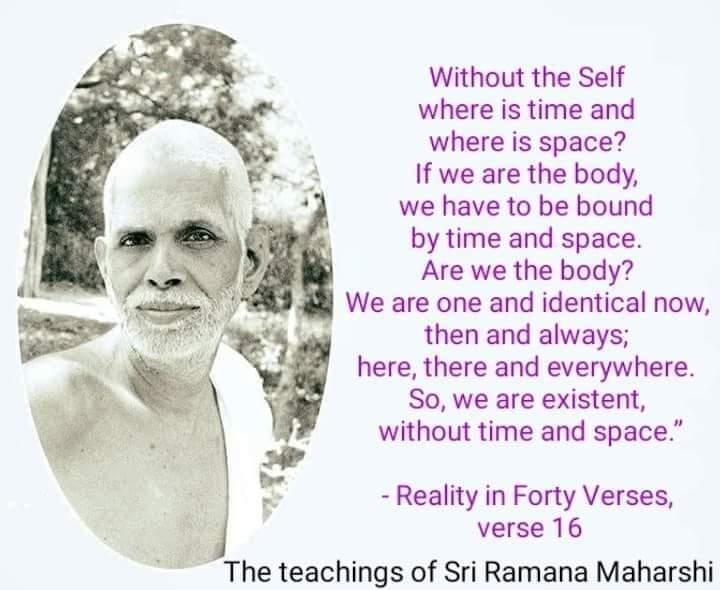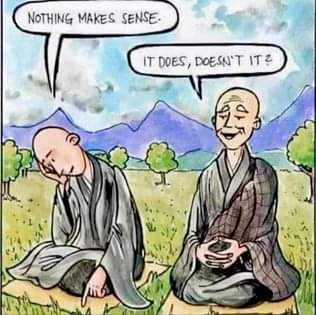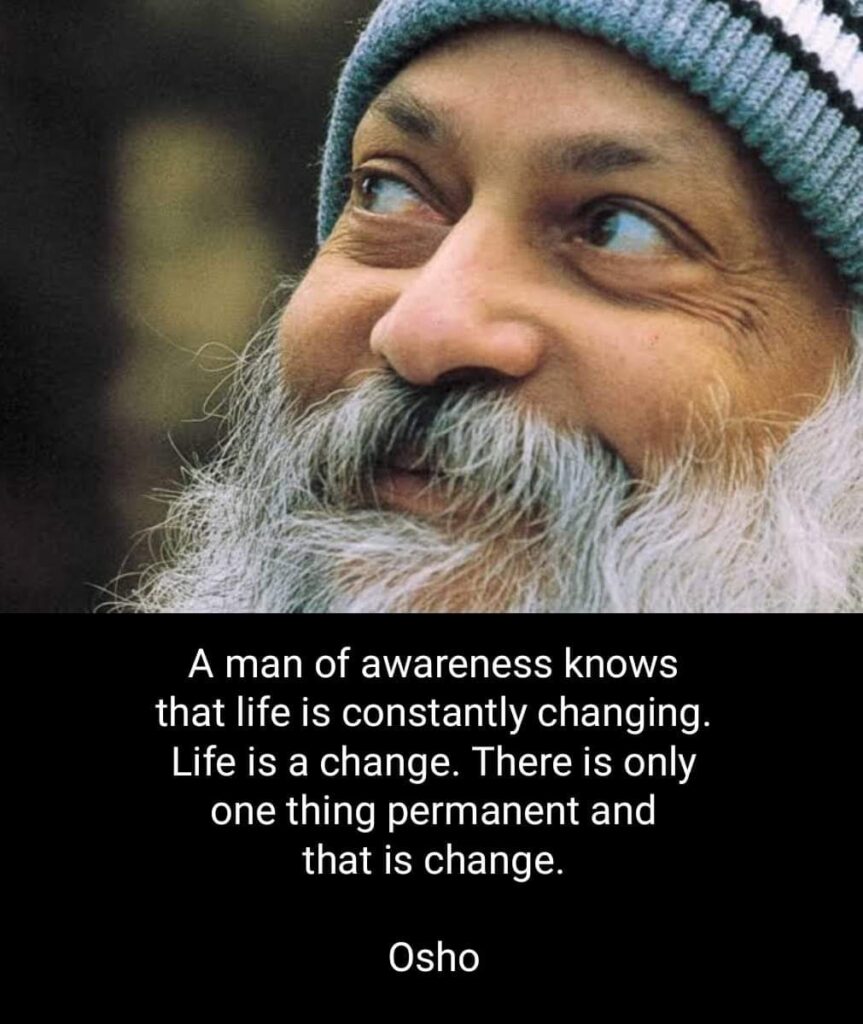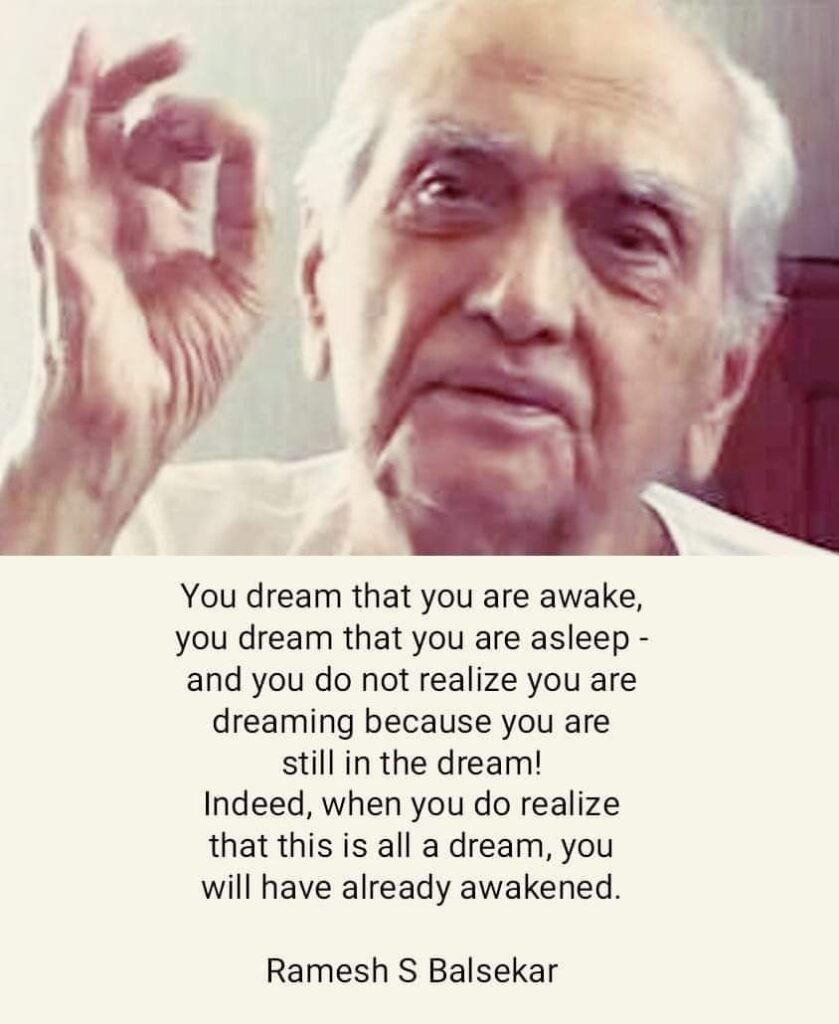Sometimes when we’ve looked up to a teacher or two for a loooong time it’s scary to even think we may have broken through (gone beyond) them in some area. We enter a lonely abyss and find – WOW!! – a whole new freedom! Beyond amazing.
Sweet nothingness!
nonsense, near death and real life find meeting point
“Early Greek philosophers understood full well that people sometimes report spiritual experiences when they are revived from close calls with death. Plato wrote about the famous case of a soldier who apparently died in battle but spontaneously revived at his funeral. The soldier told amazed spectators that he had left his body and went through a passageway into another world. Plato thought that such accounts indicated a transcendent world beyond death. Another Greek philosopher, Democritus, thought differently about experiences like those. Democritus had figured out that things in the world are composed of minute, indivisible particles—atoms—that are too small to be seen. Democritus wrote that the experiences of people who recovered from apparent death were caused by residual biological activity in the body. He said that there is no such thing as a moment of death; dying is a process. The debate about near-death experiences has not progressed much since then. Some claim that near-death experiences are evidence of life after death. Others claim that the experiences result from oxygen deprivation to the brain. This book explodes that old framework of debate by setting out an entirely new way of thinking. Specifically, this book solves the primary problem that previously prevented real advances toward answering the question of life after death. David Hume (1711–1776) was a renowned philosopher who refined our concepts of causation and inductive reasoning. His famous skeptical works helped shape what we know as the scientific mind. In an incisive analysis, Hume pinpointed the real problem of inquiring into the afterlife. Hume said, By the mere light of reason it seems difficult to prove the Immortality of the Soul…Some new species of logic is requisite for that purpose, and some new faculties of the mind that they may enable us to comprehend that logic. 1 Hume was right. In reality, we can’t solve the afterlife problem with the logic we have and the mind we have. The logic you are using right now as you read this is based on literal meaning. In that logic, “There is life after death”is a self-contradiction. After all, “death”just means “the final, irreversible cessation of life.”Hence, saying that “there is life after the final, irreversible cessation of life”is just meaningless. This book solves Hume’s problem by setting out a new logic—a logic of nonsense. Learning these new rational principles will actually activate previously hidden powers of your mind. At the end of this book, all these new logical principles and new powers of the mind will come together. Then we will be able to shine astonishing new light on life after death and other big questions of science and religion. After a stint as a philosophy professor, I went to medical school. I soon noticed that patients who were delirious, intoxicated, psychotic, severely stressed, or confused often talked nonsense. Moreover, when ill patients talked nonsense involuntarily, they talked the same types of nonsense that authors like Dr. Seuss and Lewis Carroll wrote deliberately. That is, nonsense is nonsense whether it is deliberate or involuntary. Eventually, I brought together all I had learned into a semester-length university course on nonsense, which I taught numerous times. Students learned about the many important psychological and spiritual effects of nonsense and the many roles nonsense plays in humor, songs, advertising, literature, religion, and the quest for knowledge. My students learned to recognize more than seventy different types of nonsense, describe their structures, and write their own examples. Similarly, here you will learn about the nature of nonsense, its various forms, and why it is important. From there, we’ll look at deep connections between nonsense and the mind to bring the hidden, unconscious world of nonsense fully into your conscious mind and better understand both the rules it follows and the rules it breaks. You’ll also learn about the spiritual significance of nonsense and how it has appeared historically in sacred texts, ritual and magical practices, and tradition for inducing transcendent or mystical states of consciousness. Next we’ll review the relationships between nonsense and our search for rational knowledge. In addition, we’ll take a look at the important topic of misuses of nonsense and how it is sometimes used for manipulation and selfish purposes. And finally, with a clear foundation of nonsense set, we’ll review the fascinating topic of how it plays a role in our understanding of life after death. The students in my university course also completed nonsense exercises as part of their practice, which awakened unknown cognitive and creative powers of their minds. The exercises I designed for my courses are reprinted throughout Chapter 2 in this book for your own practice. By completing them, you will find that you are able to think logically and creatively about questions that previously eluded reason, and you will attain a revolutionary new understanding of the mysteries of the next life.” – Raymond Moody
Thoughts?
How to talk 🤔, write✍ or address an audience 🤣
WHY, OH WHY, can’t mankind (1) look for the [a] premise and [b] definition of terms oftentimes but not always clearly provided by the speaker (2) enter into the ensuing discussion adhering strictly to the “givens” and (3) draw conclusions based strictly on the fundamentals of said discussion? Pulling in a brand new element is tantamount to expecting your interlocutor to join you in your aphoristic juxtaposition of apples and oranges.
The Self: ever-present?
Some time ago, a Bengali youth asked Bhagavan,
“You say that the Self is present at all times and at all places. Where exactly is that ‘I’?”
Bhagavan replied with a smile,
“When I say you are present at all times and at all places and you ask where is that ‘I’, it is something like asking, when you are in Tiruvannamalai, ‘Where is Tiruvannamalai?’ When you are everywhere, where are you to search?
The real delusion is the feeling that you are the body. When you get rid of that delusion, what remains is your Self. You should search for a thing which is not with you but where is the need to search for a thing which is always with you?
All sadhanas are for getting rid of the delusion that you are the body.
The knowledge that ‘I am’ is always there:
call it Atma, or Paramatma or whatever you like. One should get rid of the idea that ‘I am the body’. There is no need to search for that ‘I’ that is the self.
That Self is all-pervading.”
As an illustration of this, I give hereunder the words of Bhagavan in “Unnadhi Nalupadhi”:
Without the Self
where is time and where is space?
If we are the body,
we have to be bound by time and space.
Are we the body?
We are one and identical now, then and
always; here, there and everywhere.
So, we are existent,
without time and space.”
- Reality in Forty Verses, verse 16
_______Letters from Sri Ramanasramam.
Excerpt from Chapter (73)
THE ‘I’ IS THE MIND ITSELF

Only thing that’s permanent is change!
You dream you’re awake
IT: starting and staying with the answer
A CRITICAL QUESTION
When sharing the “What is being shared here is…”, the “No me, no you, no person…”, the “Open Secret and beyond…”, the “Beyond non-duality…”, the “Start with the Answer and stay there”(rjs) [referring to the same thing in all of the above], ‘I’ am keenly aware of why it is counter-intuitive to give ‘IT’ a label. But don’t we – or do we – oh golly I dunno! don’t we need to have some consistent way of identifying ‘IT’ in the literature?
In this treatment, I’m referring to the issue by the very temporary term IT. That’s not helpful as a solution for speakers and writers: I guess I just want it to be abundantly clear that the purity and absolute uniqueness of IT is fully appreciated and supported by “me”.
Why do “I” care so much about this labeling thing? Because I care so deeply and passionately about IT that I shudder inside and out when I see IT so unfairly misrepresented.
IT is not out there just to give other disciplines a rolling-the-eyes headache. IT isn’t a .001-second path: IT is always and already THERE (starting- and- staying- with- the- answer).
Block Universe (prakriti) in Dzogchen
Try this…
An Infinite Field of Dependent Histories
What this means is: an apple (or any phenomena) is itself the sum total of its entire prior history. Further, any existing or contributing aspect of the apple’s history, such as the apple seed, the earth it grew in, the necessary nutrients, the water, the sunlight etc. etc. , are required, as well as also each of those contributing aspects or factors, will have their own prior histories as well.
This understanding reveals a vision which spans the entire universe as being an infinitely vast network of interdependent histories.
No “thing”, subjectively mental or objectively “material” can be isolated as though existing apart from its current total field of supporting dependencies and its prior developmental history of previously existing supporting and influencing relationships.
To think otherwise is itself the definition of “magical thinking”.
Now imagine that this “total field of interdependencies” includes the past, present and future as a single field or as a unified network of interconnected relationships or hierarchies. This further defines Einstein’s concept of an all inclusive “block universe” comprised of past, present and future as a fixed and unchanging 4D hologram.
So it doesn’t matter which or whatever philosophical or metaphysical or religious framework one wishes to superimpose upon this fixed field of Reality, it won’t alter what’s primordially there.
The future is never other than the extension of its history extended forward in time. An apple seed will never develop into a lemon. A lemon’s history will have to have something other than an apple seed as it’s origin. And so it is with ALL mental and material phenomena including the mind.
But the above description doesn’t include the permanent (timeless) Knowing Presence of Awareness. Knowing Awareness has no history, has no past, present or future. It’s outside of time, mind, thought, identity, self, form and event, yet is all pervading without dimension, like a borderless mirror in which reflections simply appear and are known. But better than the mirror analogy is one where Awareness is the unchanging empty space which hosts the Universal Hologram.
So whatever “spin” you want to put upon the nature and characteristics of the “reflections” as the appearing thoughts, mind, perceptions, identities, forms, bodies, objects, and energies; no utterly simple, elegant, complex or fanciful mental construct or paradigm will ever influence or impact the Knowing Awareness in which they harmlessly appear.
In Samkhya the interdependent “field” of past, present and future phenomena; mental and material, is called “prakriti”.
The empty Knowing Awareness is called Purusha or Jña in Samkhya.
Does Prakriti (the block universe) arise as the creative potential or expression of Knowing Awareness itself or are they always in a dualistic relationship?
Seeing how both pervade the other completely, to speak of “two” is incoherent. To see changing reflections as being “identical” to the unchanging mirror in which they appear, is equally incoherent.
It is only the historical or evolved form of prakriti known as the intellect (buddhi) which has concerns regarding duality or non-duality as being relevant philosophical positions.
The main task in Dzogchen is to differentiate Awareness from mind, thought, and the conceptualizing intellect. The egoic self identity is one of mind’s products. It is only the mind and intellect which “seem” to obscure rigpa.
Mind, thought and intellect are dependent prakriti, Awareness is neither prakriti nor is dependent.
That which is aware OF thoughts, images, perceptions, memories, logic, intellect, self and mind IS rigpa Awareness.
°▪︎°▪︎°▪︎°▪︎°▪︎°▪︎°▪︎°▪︎°▪︎°▪︎
posted by Jackson Peterson
Robin Sharing



